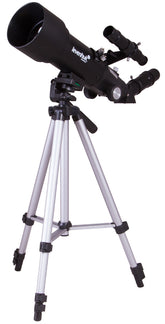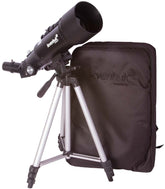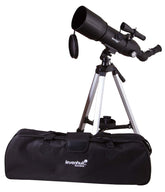Madeira Optics guide to buying Levenhuk Binoculars
Since Spring 2015, Levenhuk has worked to completely renew and improve its range of Binoculars, available to customers worldwide. The Levenhuk Bino and Energy models have been replaced with new and improved binoculars series, Karma, Sherman, and Atom, with 47 models available across the three ranges.
With so many options available, it may be a daunting task to decide which to choose. Follow our guide and we’ll help you make your decision. With comprehensive information on entry-level models, right through to high-end pieces.
When choosing a set of binoculars, there are three things to consider.
- Application – What is your primary reason for owning a set of Levenhuk Binoculars
- Price – How much are you willing to spend on your new binoculars.
- Appearance – What is your preference for colour and style?
Application
So, you have decided to invest in a high-quality pair of Binoculars. First, ask yourself why you need them? After this stage you can safely eliminate models that do not suit your requirements, narrowing down the list of available optics.
Binoculars for everyday use
If you enjoy spending your time out in nature, enjoying beautiful landscapes, and watching animals and birds in their natural habitat, or you’re passionate about urban architecture then a lightweight, more compact model could be right for you. Compact sets allow you to travel easily without worrying about bulky items weighing you down and lightweight can help avoid hand fatigue, distracting you from your object and causing discomfort.
Typical binoculars for everyday use weigh around 140-700 grams and have a 6x to 8x magnification, with a 25-40mm objective lens. Compact binoculars may have a roof prism as opposed to a full-sized Porro prism, but do not sacrifice image quality.
Binoculars for Field Observations
Widely used by fishermen, hunters, guards and sailing enthusiasts, Field Binoculars have larger dimensions and are more powerful. It’s normal to find 10-12x magnification and an objective lens between 40-50mm. This greater magnification allows you to observe very distant objects in detail. A powerful, high-aperture lens can collect more light, producing brighter and more vivid images. More weight can be expected with larger equipment and Field Binoculars usually weigh between 700 grams and 1.2kg.
Advanced Binoculars
We use the term ‘advanced’ to describe a level of binoculars that meets a specific requirement defined by the user. Greater technical specifications and higher quality materials with more specialist applications in mind, from the design stages, through manufacturing.
Characteristics of Advanced Binoculars may include:
- Distant object observations – Greater magnification ranges between 12x and 16x
- Observation of nearby objects – Pay attention to the minimum focal distance. The smaller the value, the closer you can get to the object.
- Wide field observations – Wide fields of view make capturing large areas of interest possible. Normally binoculars with a wide field of view can view at least 400 yards from point to point.
- Low and poor visibility conditions – Conducting observations at dawn or dusk, or in areas of high humidity or poor weather conditions, then you should consider a set of binoculars that are hermetically sealed and have high aperture lenses. A hermetic, nitrogen sealed lens will prevent moisture from entering the inner parts of your instrument and protect them from fogging in high humidity or rapid changes in temperature.
- High quality, realistic images – Binoculars that have complex, multi-element optical systems can capture images in greater detail with more realistic views.
Difference between Porro and Prism Lenses
Depending on the style, either Porro or Prism lenses are available. Typically, classic field binoculars offer a Porro Prism optical design. The loss of light in a prism system is considered zero, ensuring high image quality.
Roof Prism designs are more elaborate but allow for compact, weight-saving designs. Images are good quality, but not as bright compared to a traditional Porro Prism model.

What’s your budget?
Once you have determined the scope of your activity, or which activity you will primarily use your binoculars, you can consider the differences in cost and make an informed decision based on your budget.
The Levenhuk Atom range begins at €25 and rises to €100. At the entry-level price, you can buy the compact Atom 10x25. A lightweight, rubberised-armoured body, roof prism design. A central focusing system allows you to quickly set the focus on your desired object. Ideal for casual observations, hiking and bird watching.
The Karma Range is available from €50 to €150, and you can expect a compact size, wide field of view and sharp, crystal-clear images. The Levenhuk Karma Plus 8x25 Binoculars are available from Madeira optic for €64.95 and are ideal for urban and picturesque landscape observations. A waterproof, hermetic lens, avoids fogging offering a user-friendly experience every time.
On the higher end, you can find the Levenhuk Sherman Range. High-end, quality optics suitable for observations under extreme conditions. The Sherman Pro 12x50 feature a 12x magnification paired with a 50mm objective length. A Porro Prism design, hermetically sealed shell with multi-coated BaK-4 glass lenses. Retailing for €204.95, the Sherman Pro offer an unmatched viewing experience in all conditions.
Appearance
The final step when choosing your Binoculars is your personal preference for the colour and additional features that aren’t associated with the technical specification. All Levenhuk Binoculars are available in Black, Light Grey, and Dark Green options. A folding design and adjustments for individual eyesight are also important decisions. If you wear glasses, consider a model with eyepiece diopter adjustment or twist-up eye-cups. A tripod mount may be necessary, depending on the subject you choose to observe, so check to see that your chosen Binoculars have a jack for a tripod adaptor.
Taking this information into account, you should be able to make an informed decision about your purchase. All Levenhuk binoculars come with eyepiece and objective lens protective caps, carry pouch, neck strap and cleaning cloth. A lifetime warranty is available when you register your purchase at Levenhuk.com
Visit our Funchal Store, Zoom’n’Joy, to discover the latest range of Levenhuk products, and speak with a member of our experienced team who can help you find the right set of binoculars for you.












